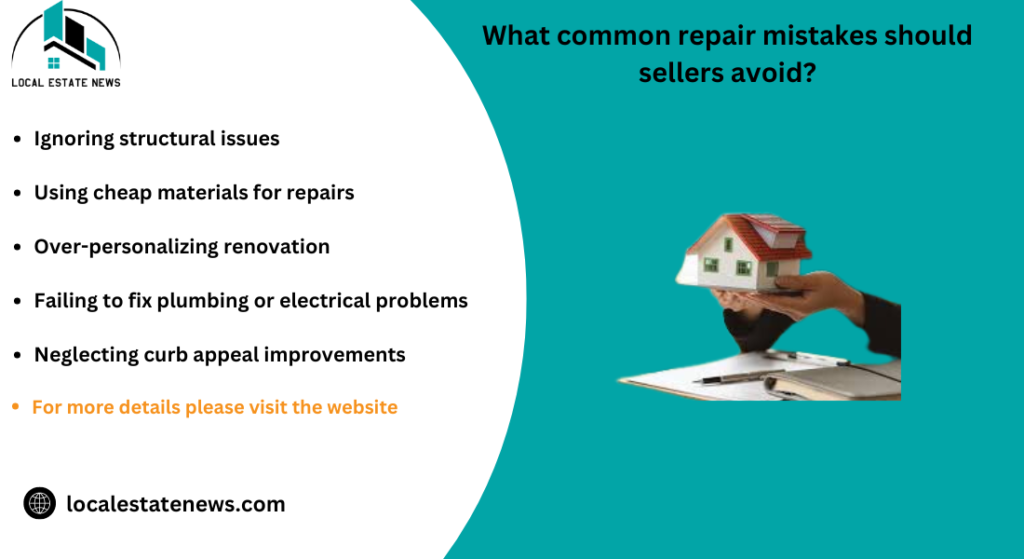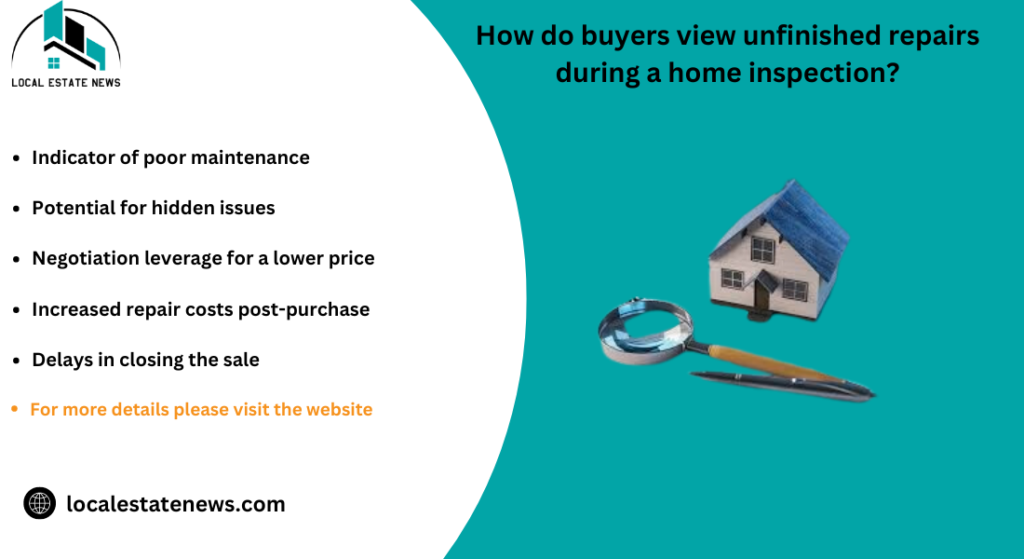Home Repairs Before Sale is a significant financial decision, and making the right home repairs before sale putting it on the market can drastically affect your sale price. Homebuyers often look for properties that are move-in ready and free from obvious repair needs. By addressing key repairs, homeowners can boost their properties value and appeal to a broader range of buyers. It is improving curb appeal, fixing structural issues, or completing minor cosmetic repairs, focusing on the right areas can lead to a quicker sale at a higher price. In this guide, we will cover the most important home repairs before sale to consider before selling, helping you maximize your return on investment.
What home repairs add the most value before selling?
Not all repairs are created equal when it comes to adding value to your home before selling. Some improvements offer a higher return on investment (ROI) than others, particularly those that improve both the functionality and appearance of the property. Kitchens and bathrooms tend to yield the highest ROI because they are often the first areas buyers evaluate. Replacing outdated fixtures, upgrading countertops, and refreshing cabinetry can make these spaces more attractive without requiring a full renovation. home repairs before sale
High value repair is enhancing curb appeal. First impressions matter, and simple upgrades like repainting the front door, adding landscaping elements, and repairing walkways can significantly increase your homes appeal from the outside. Buyers are more likely to enter with a positive mindset if the exterior is well-maintained. Minor cosmetic repairs, like fixing cracks in walls or replacing worn-out flooring, can give buyers confidence that the property is well-cared for.
Should you focus on curb appeal or interior repairs first?
When it comes to deciding whether to prioritize curb appeal or interior repairs, many experts agree that curb appeal should come first. The exterior of the home is what buyers see first, and a strong first impression can set a positive tone for the rest of the viewing. If the outside of your home looks neglected, potential buyers may assume that the interior has also been poorly maintained. Start with simple fixes like cleaning up the landscaping, repainting the front door, and ensuring the driveway and sidewalks are in good condition.
Once the curb appeal is addressed, focus on interior home repairs before sale. Target the high-traffic areas of the home, the kitchen, living room, and bathrooms. Fresh paint, updated fixtures, and repaired flooring can enhance these spaces without breaking the bank. The key is to strike a balance between functional and cosmetic repairs so the home feels inviting and well-maintained inside and out.
How do minor cosmetic fixes influence home sale prices?
Minor cosmetic fixes may seem small, but they can have a substantial impact on the perceived value of your home. Buyers often make judgments about a properties condition based on the surface appearance, and even minor issues like chipped paint, outdated hardware, or stained carpets can create a negative impression. Simple fixes, repainting walls in neutral colors, replacing old light fixtures, and repairing worn or scratched surfaces can make a home feel fresher and more inviting.
These small improvements help potential buyers imagine themselves living in the space, increasing their emotional attachment to the property. Homes that look move-in ready command higher offers because buyers perceive fewer upfront costs associated with repairs. While cosmetic fixes may not directly increase the homes structural value, they can certainly elevate the marketability and the final sale price.

Which major home repairs are worth investing in before selling?
While cosmetic repairs are important, some major home repairs before sale can significantly increase your homes value and are worth the investment. Roof replacement is often one of the most important major repairs. If your roof is nearing the end of its life or has visible damage, replacing it can prevent buyer hesitation. A new roof signals that the home is structurally sound and free from costly future repairs, which is a major selling point for buyers. Upgraded roofing materials, energy-efficient or impact-resistant options, can further boost your home’s value.
Foundation and structural repairs are also critical. Buyers tend to shy away from homes with foundation issues, as they can lead to significant expenses down the line. Fixing cracks or settling issues can reassure buyers that the property is a solid investment. HVAC system updates are another worthwhile repair. Ensuring that heating, ventilation, and air conditioning systems are up-to-date not only makes the home more comfortable but also improves energy efficiency, selling points for eco-conscious buyers.
How does replacing the roof impact the resale value of a home?
Replacing an aging or damaged roof can have a significant impact on a homes resale value. Buyers are often concerned about potential future costs, and a new roof provides peace of mind that they won’t face expensive repairs right after moving in. Homes with new roofs are often seen as lower-risk investments, allowing sellers to command a higher asking price. In fact, many real estate professionals highlight roof condition as a key factor in determining the overall marketability of a home.
An immediate value a new roof provides, certain roofing materials can offer added benefits. Energy-efficient or eco-friendly roofing, solar tiles or cool roofs, can appeal to environmentally-conscious buyers. These types of upgrades not only enhance the home’s functionality but also align with current trends in sustainable living, potentially attracting a broader pool of buyers and further increasing the property’s resale value.
Should you upgrade the kitchen or bathrooms before selling?
Upgrading kitchens and bathrooms before selling a home is often considered a high-ROI strategy. These rooms are frequently focal points for buyers, and modern, updated features can dramatically enhance a home’s appeal. Full remodels can be costly, so homeowners should focus on targeted upgrades that offer the best return on investment. For kitchens, replacing countertops, upgrading to energy-efficient appliances, and installing modern light fixtures can refresh the space without the need for a complete overhaul.
Bathrooms are another area where smart upgrades can make a big difference. Simple improvements like replacing old faucets, re-grouting tiles, and upgrading to a more modern vanity can make the bathroom feel more luxurious without a full remodel. Buyers appreciate updated bathrooms because they are perceived as one of the more expensive areas to renovate. Ensuring these rooms feel fresh and functional can make the property more attractive and increase its sale price.
How do electrical and plumbing repairs affect a home’s marketability?
Electrical and plumbing systems are critical to a home’s functionality, and potential buyers expect these systems to be in top condition. Addressing any outdated or faulty electrical wiring is essential, especially in older homes. Buyers are likely to ask about the state of the electrical system during inspections, and issues like overloaded circuits or ungrounded outlets can be red flags. Fixing these issues before listing can prevent buyers from negotiating for a lower price or backing out altogether. Upgrading the electrical panel to handle modern energy demands is another investment that can increase the home’s appeal. Home repairs before sale
Plumbing repairs also play a significant role in marketability. Leaky faucets, slow drains, and outdated piping can make a home seem neglected, even if it’s structurally sound. Ensuring that pipes, water heaters, and all plumbing fixtures are functioning properly can reassure buyers that they won’t face expensive water damage repairs in the near future. Small upgrades, like installing water-efficient fixtures, can also add value and appeal to eco-conscious buyers who are interested in homes with sustainable features.

Is repainting your house a necessary repair before listing it for sale?
Repainting your home before listing it for sale is often a simple yet highly effective way to increase its appeal and perceived value. A fresh coat of paint can make rooms look cleaner, brighter, and more modern. Neutral colors like whites, grays, and light beiges tend to work best, as they appeal to a broader range of buyers by creating a blank canvas. Bright or bold colors, on the other hand, can be polarizing and may limit the homes appeal. Repainting can also help cover up minor imperfections, scuffs or faded areas, which can detract from a home’s overall look.
Interior painting, don’t overlook the exterior. Curb appeal plays a huge role in attracting buyers, and an exterior paint refresh can make a home stand out. Whether it is repainting the trim, doors, or even the full exterior, this repair can give the home a well-maintained, inviting appearance, potentially leading to higher offers. Repainting is a cost-effective upgrade that can greatly enhance a home’s marketability without requiring a large investment..
What are the benefits of staging repairs vs. renovations before a sale?
Staging home repairs before sale rather than full renovations can be a strategic choice for sellers looking to maximize their return on investment. Repairs focus on fixing what is broken or outdated, which can be more cost-effective than a full renovation. For example, rather than completely gutting a kitchen, making targeted home repairs before sale like fixing a broken cabinet, replacing worn-out countertops, or installing new faucets can refresh the space without the need for a massive budget. This approach allows sellers to present a home that looks well-maintained and move-in ready without committing to extensive renovations.
The benefit of staging repairs is that it reduces the upfront costs while still addressing the key areas buyers focus on. It also allows buyers to visualize making their own updates in the future, without feeling overwhelmed by immediate large-scale renovations. Repairs also ensure that buyers won’t face any major functional issues, like leaks or electrical problems, which could otherwise cause them to renegotiate or walk away. Staging rephome repairs before sale airs help you balance the cost of improvements with the perceived increase, making it a savvy strategy for sellers who want to stay within a budget. Home repairs before sale
How can you assess the ROI of repairs before putting your house on the market?
Assessing the return on investment (ROI) of repairs before selling your home is crucial to ensure you’re spending money in the right places. To start, you should prioritize repairs that directly impact the home’s functionality and appeal, fixing leaks, upgrading outdated appliances, or repairing damaged flooring. These repairs typically offer higher ROI because they improve the buyer’s perception of the home as well-maintained and ready for move-in.
For more expensive repairs like roof replacements or kitchen remodels, consider the local market conditions. If you are selling in a competitive market, high-end repairs can help you command a higher price. In slower markets, you may not recoup as much of your investment. Tools like cost-vs-value reports or consulting with a real estate agent can help you estimate which repairs will provide the best financial return based on current trends and buyer expectations in your area.
What common repair mistakes should sellers avoid?
While making repairs before selling is essential, some common mistakes can end up costing sellers more than they add in value. One frequent mistake is over-improving the home beyond the neighbourhoods standards. For instance, installing a luxury kitchen in a mid-tier neighborhood may not provide the expected return, as buyers looking in that area might not be willing to pay for the upgrade. It is important to align repairs with what similar homes in the area offer to ensure you’re not pricing yourself out of the market. Master Real Estate Photography: Tips, Stand Out and Sell Faster
And mistake is neglecting essential repairs in favor of cosmetic ones. While new paint and fixtures can enhance a homes appeal, ignoring structural or mechanical issues, a leaking roof or outdated plumbing, can lead to problems during inspections. Buyers are more likely to renegotiate or request repair credits for these issues, potentially delaying the sale. Focusing on a balanced approach addressing both cosmetic and fundamental repairs will yield better results in terms of sale price and speed.

Should you DIY or hire professionals for home repairs before a sale?
When preparing a home for sale, one key decision is whether to tackle repairs yourself or hire professionals. DIY repairs can save money, especially for smaller tasks like painting, fixing minor leaks, or updating fixtures. It is important to be honest about your skill level. Poorly executed DIY repairs can be a turnoff for buyers and may need to be redone, costing you more in the long run. Tasks like electrical work, plumbing repairs, or roof fixes should generally be left to licensed professionals to ensure they meet safety standards and pass inspections.
Hiring professionals comes with the assurance of quality work, which can be particularly important for larger, more complex repairs. Buyers often feel more confident in homes where significant repairs like HVAC upgrades or foundation fixes have been handled by certified experts. Although the upfront cost is higher, the potential to avoid inspection issues or buyer concerns can make professional repairs a worthwhile investment.
How do energy efficiency upgrades help sell a home faster?
Energy efficiency upgrades are becoming increasingly important to homebuyers who are looking for cost savings and sustainability. Simple upgrades, like installing energy-efficient windows, upgrading to LED lighting, or adding insulation, can make a significant impact. These improvements lower utility bills, which can be a selling point for budget-conscious buyers, as well as eco-conscious buyers who are seeking environmentally friendly homes. Highlighting energy-efficient features in your home’s listing can differentiate your property in a competitive market and attract buyers looking for long-term savings.
Larger energy efficiency investments, solar panels or smart thermostats, can also boost a home’s marketability. Buyers may be willing to pay a premium for homes with these features because they provide ongoing benefits. Government incentives for solar installations and the growing trend toward sustainability make energy-efficient homes more attractive. By making these upgrades before listing your home, you can tap into a growing segment of the market and potentially reduce the time it takes to home repairs before sale.
What role do foundation and structural repairs play in the home sale process?
Foundation and structural repairs are critical when it comes to selling a home, as they address the fundamental integrity of the property. A home with foundation issues can raise serious concerns for buyers and often leads to a much lower offer, if any, due to the fear of long-term problems or costly repairs. Addressing foundation cracks, settling issues, or any signs of water damage before listing is essential to ensure that the home passes inspection and that buyers feel confident in its stability.
Structural repairs also play a key role in appraisals and loan approvals. Lenders are less likely to approve a mortgage for homes with significant structural damage, which can shrink your pool of potential buyers. By making necessary home repairs before sale upfront, you avoid delays in the sale process and create a more secure and desirable property. These repairs, while sometimes costly, are often non-negotiable if you want to achieve a successful sale.
How do buyers view unfinished repairs during a home inspection?
Unfinished repairs can be a red flag for potential buyers during a home inspection. Incomplete projects, partially renovated rooms or visible repair work that hasn’t been completed, can give buyers the impression that the home has been poorly maintained or that they may need to invest time and money into finishing the work themselves. This can lead to lower offers or cause buyers to walk away from the deal entirely.
In some cases, unfinished home repairs before sale might raise concerns about hidden issues. For example, an unfinished plumbing project might lead buyers to question whether there are underlying water damage or structural problems. Addressing and completing all repairs before listing your home ensures that it appears move in ready, which is a significant selling point for many buyers. Homes that are free from visible home repairs before sale are more likely to pass inspections smoothly and avoid any last-minute negotiations for repair credits or price reductions.

What’s the best approach to handling home repairs before sale?
When preparing your home for sale, the best approach to handling repairs is a balanced, strategic one. Focus first on essential repairs that improve the home’s functionality, fixing structural issues, addressing electrical and plumbing concerns, and replacing an aging roof. These are the types of repairs that buyers expect and are often non-negotiable during the inspection process. Neglecting these critical areas can lead to complications, lower offers or extended time on the market. Marketing your home fully detail
Once the essential repairs are completed, concentrate on cosmetic improvements that enhance the visual appeal of the home. Painting, minor kitchen and bathroom updates, and landscaping improvements can elevate the perceived value of your property. Consider prioritizing energy efficiency upgrades as well, as they can appeal to modern buyers and help your home stand out in a competitive market.
A well-maintained home that appears move-in ready, free from significant repair needs, will not only sell faster but also attract higher offers. By approaching home repairs before sale with a focus on both functionality and aesthetics, sellers can maximize their ROI and enjoy a smoother sale process.









